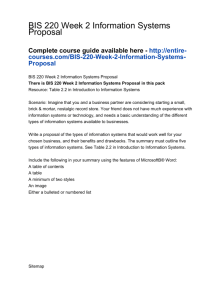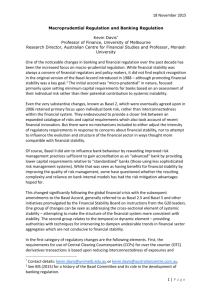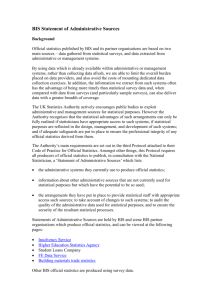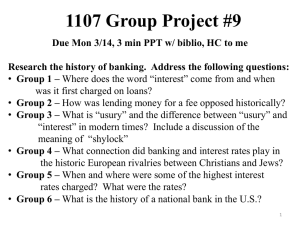ppt
advertisement
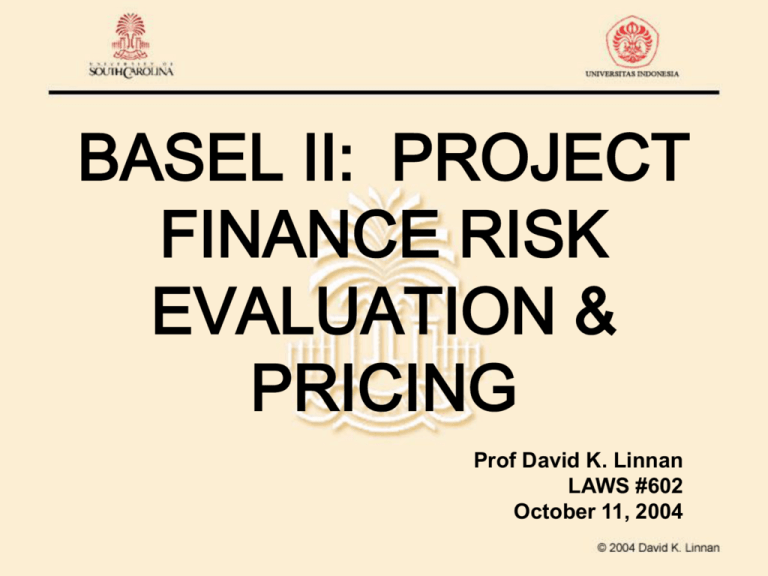
BASEL II: PROJECT FINANCE RISK EVALUATION & PRICING Prof David K. Linnan LAWS #602 October 11, 2004 CONCEPTS I BASIC CONCEPTS FOR TODAY 1. Traditional differing regulatory concepts in capital, insurance & banking markets (i.e., financial sector) 2. Changes in banking from old regulation, to Basel I, now Basel II coming 3. New risk and disclosure emphasis of Basel II affects both regulation & pricing, plus risk calculations as effects profitability CONCEPTS II BASIC CONCEPTS FOR TODAY (CONT’D) 4. Expectation theory of interest rates (decomposing elements of risk in interest rates) 5. Credit spread concept & empirical observations re project finance as affects deal structure (political risk insurance), term (risk on short vs long) & pricing (spread) 6. Interpretation re regulatory policy and structuring transactions in Indonesia 7. Reflection in Indonesian materials provided? FIN SECTOR REG FINANCIAL SECTOR STRUCTURES & HISTORIAL REGULATION 1. Going back 25+ years, differing patterns of financial sector development a. Japan & Continental Europe (old-style) bank-based, stressing private companies b. UK & US tradition (old-style) capital market-based, stressing public companies c. Underdeveloped financial sector elsewhere, chiefly state directing development finance CAPITAL MARKETS REG I SECURITIES HOUSES & SYSTEMIC RISK 1. Underwriter-dealer functions risking professionals’ capital, broker function buying & selling nominally risking client capital only 2. But systemic risk because brokers guaranty clearing & settlement, so if their client disavows order they pay anyway 3. Capital adequacy traditionally a liquidity calculation as regulatory approach, mark to market each day (net working capital, e.g., Bapepam regulation V.D.5) CAPITAL MARKETS REG II SECURITIES HOUSES & SYSTEMIC RISK (CONT’D) 4. Relatively low capital as long as acting as agent (broker) vs principal (dealerunderwriter) 5. Differing traditions w/in capital markets world of exchange-based (gentlemens’ club vs SRO) vs central government regulation 6. From an operational viewpoint lawyer’s focus on regulation as danger of capital market manipulation misplaced as operational issues more typically clearing & settlement (systemic risk issues) CAN RAISE CAPITAL REQUIREMENTS, OR MAY BE HIGHLY CAPITALIZED IN UNIVERSAL BANKING SYSTEM, BUT BENEFIT OF CAPITAL MARKET SYSTEM RELATIVELY OPEN ENTRY (SOCIAL CHOICE) BANKING MARKET REG I DIFFERENT RISKS IN BANKING 1. Banks borrow short (via deposits) and lend long, so always liquidity problems (triggering feared bank run) and negative economic effects 2. Traditionally, relatively high capitalization required of banks alongside prudential regulation to ensure no problems on lending side where bank acting as principal (risking own equity) 3. Risk diversification among banking institutions traditionally via practices like syndicating loans, lending in different markets, etc. BANKING MARKET REG II DIFFERENT RISKS IN BANKING (CONT’D) 4. Problem starting early 1980s with derivatives & banks increasingly engaging in own account trading, raising principal risks because lending markets became competitive & generic 5. Prudential regulation of the loan portfolio becomes increasingly misplaced as sole regulatory focus as banking activities increase internationally 6. Basel I (1984) source of 8% capital adequacy idea, originally attributed capital via lines of business (but regulators realized relatively quickly that old prudential regulation model with inspectors coming annually was problematic given new trading risks, etc. which could sink institutions overnight (and could not understand newer derivatives risk, etc.) BANKING MARKET REG III DIFFERENT RISKS IN BANKING (CONT’D) 7. Basel II represents a split under which can adhere to something that looks like older capital adequacy system by activity category but also INDIVIDUAL credit risk too re credit ratings, or go to new internally managed risk system allocating capital & managing risk INDIVIDUALLY (by computer) 8. Basel II details addresses different risks in banking, but begins to look more like liquidity-based regulation in capital markets to avoid systemic risk (also with deposit insurance to stop bank runs, etc.) plus disclosure obligations 9. BIS as advisory, plus newer fin sector reg as OJK? PUT ASIDE PROBLEMS OF INSURANCE REG, BUT THERE PROBLEM IS LONG-TAILED RISKS AND ABILITY TO MEET FAR FUTURE PROMISES BASED UPON CURRENT INVESTMENTS (E.G., TASPEN & JAMSOTEK ISSUES IF THEY MAKE THE SAME KINDS OF LOANS THAT BANKS DID BEFORE 1997) FIN SECTOR RISKS AGAIN DIFFERENT RISKS IN CAPITAL MARKETS, BANKING & INSURANCE 1. In capital markets, feared risk is systemic problem at clearing & settlement stage (freezing markets, etc.) & arrives from either clients disavowing trades or bad trades as principal (BUT NO “GOVT” EXPOSURE BEYOND FEAR OF FREEZING MARKETS) 2. In banking, feared risk is illiquidity due to obligationasset mismatch (risk of run on bank) & arises from nature of business in borrowing short while lending long leading to systemic risk plus possible loan losses (GOVT EXPOSURE TYPICALLY VIA DEPOSIT INSURANCE OR SIMILAR GUARANTiES) 3. In insurance, feared risks are correctly interpreting long-tailed risk at underwriting stage for claims to be paid in far future, linked with investment risk re what is done with premiums paid until then (WHETHER GOVT RISK OR NOT DEPENDS UPON EXISTENCE & NATURE GUARANTY FUNDS) BASEL II’S 3 PILLARS (I) BASEL II 3 NEW REGULATORY PILLARS (BIS RELEASE 06/26/04) Basel II represents a split under which can either mostly adhere to something that looks like older capital adequacy system by activity category (but individualized credit risk too), or go to new internally managed risk system allocating capital & managing risk individually (by computer): 1. Pillar 1 requires higher capital levels for those presenting higher levels of credit risk (a) “Standardized approach” using external measures of credit risk for individuals (e.g., credit rating agencies) (b) “Internal ratings based” (IRB) approaches, IRB Foundation & IRB Advanced (c) Explicit capital charge for operational risk caused by systems, processes, staff or natural disaster failures (e.g., BNI phony loans) BASEL II’S 3 PILLARS (II) BASEL II 3 NEW REGULATORY PILLARS (BIS RELEASE 06/26/04)(CONT’D) 2. Pillar 2 requires supervisory review of bank’s internal risk assessment (so reviewing controls rather than loans, etc.) 3. Pillar 3 as market discipline, meaning pricing of bank’s securities & credit spreads, assuming disclosure of asset risk mandated BASEL II QIS 3 (I) BASEL II THIRD QUANTATATIVE IMPACT STUDY RE BANK CAPITAL CHANGES 05/05/03 1. Note that Standardized approach to Basel II requirements led to increase in capital requirements averaging 11% (including Indonesia, see page 3 QIS 3) 2. Note that the IRB Foundation approach lead to an increase in capital requirements averaging 4% (including Indonesia, see page 3 QIS 3; no figures given for comparable banks under IRB Advanced, but for major int’l banks led to a further decrease) BASEL II QIS 3 (II) BASEL II THIRD QUANTATATIVE IMPACT STUDY RE BANK CAPITAL CHANGES 05/05/03 (CONT’D) 3. How to interpret and act on presumption under table 1 page 3 QIS 3? [INSERT VIA DOC CAMERA?] EXPECTATION THEORY REMEMBER COMPOSITION OF INTEREST RATES? 1. Time Value of money .07 – 3.0% 2. Purchase Power Risk (inflation expectation) 3. Default Risk (0% for government, credit risk for corporate) 4. [Currency Risk Internationally (depends upon revaluation expectations] 5. [Liquidity Risk] DISCUSSION OF CREDIT SPREADS IN BIS WP NO. 159 EMPIRICAL RESEARCH PAPER IS LARGELY A DISCUSSION OF THE DEFAULT RISK PREMIUM DIFFERING OVER TIME OVER A YIELD CURVE BIS WP NO. 159 (1) BIS WP NO. 159, TERM STRUCTURE OF CREDIT SPREADS IN PROJECT FINANCE (AUGUST 2004) 1. Paper looks at specific character of project finance with a view to Basel II since now necessary to better understand risk for capital adequacy (and implicitly pricing) 2. Variety of empirical determinations comparing regular corporate loans to project finance loans (non-recourse) BIS WP NO. 159 (2) BIS WP NO. 159, TERM STRUCTURE OF CREDIT SPREADS IN PROJECT FINANCE (AUGUST 2004)(CONT’D) a. Leverage ratios in project finance (WB) Sector Transport Waste/water Power Roads Telecoms Mean (%) 77.86 75.00 73.07 63.07 61.25 BIS WP NO. 159 (3) BIS WP NO. 159, TERM STRUCTURE OF CREDIT SPREADS IN PROJECT FINANCE (AUGUST 2004)(CONT’D) b. (i) Credit spread different lending forms Bonds upward sloping (same slope), lineal spread function average (p. 26) (a) investment grade circa +25 to + 120 basis points (b) speculative grade circa +525 to +660 basis points (ii) Project finance loans humped shaped, flattening then decreasing around 5-7 years even without agency guarantee circa +125 basis points to +125 basis points @ 30 yrs, peaking circa + 200 basis points @ 7 yrs (p. 28) (iii) Project finance loans hump shaped also with agency guarantee (lowering credit spread overall circa 50 basis points), flattening then decreasing around 3 years circa +125 basis points to -10 basis points @ 30 yrs, peaking circa +175 basis points @ 3 yrs (P. 28) BIS WP NO. 159 (4) BIS WP NO. 159, TERM STRUCTURE OF CREDIT SPREADS IN PROJECT FINANCE (AUGUST 2004)(CONT’D) c. Distinctive nature of project finance (i) Non-recourse, so different form of lending (not regular corporate credit, rather all cash flows, etc) (ii) Political risk due to duration in regulated infrastructure sphere (iii) Agency guarantees essentially sovereign risk equalizer (so in theory trading at sovereign credit, although % coverage not entirely clear) PRICING & POLICY (I) INFERENCES FROM BIS WP NO. 159? 1. For regulatory & capital adequacy purposes, project finance loans in banking different creature from regular corporate loans, regardless whether agency guarantee 2. Given hump-shaped curve, loan duration of project finance loans means different risk treatment visible at different maturities a. Unusually shorter loans may be riskier (i) Most likely to default around 5-7 years without agency guarantee (ii) Most likely to default around 3 years with agency guarantee b. Refinancing risk if project life longer than loan duration? c. How to interpret political risk aspects of agency guarantee over time (prob with short-term cashflow calculations vs sovereign credit longer term)? PRICING & POLICY (II) INFERENCES FROM BIS WP NO. 159? (CONT’D) 1. What are regulatory (capital adequacy plus) inferences in Indonesia for different kinds of project finance deals (with or without agency guarantees, loans versus bonds)? 2. What are pricing inferences first in project finance loans, second in infrastructure regulatory setting itself? PRICING & POLICY (III) INFERENCES FROM BIS WP NO. 159? (CONT’D) 3. How should regulatory/government side recognize the nature of sovereign guarantee bodies in case of default a. Retorsion problem (cutting foreign assistance, voting against in IFIs because defaults treated as sovereign issue) b. Difference on private issuers? c. Pluses/minuses agency guarantees, ultimately contingent government debt BALI WORKSHOP? EVIDENCE IMPLICATIONS UNDERSTOOD IN BALI WORKSHOP? 1. What is picture in agenda & powerpoint of implications from BIS WP No. 159? 2. What about powerpoint emphasis on sound deals vs financial engineering (meaning agency guarantees, apparently)? 3. What about investment grade/non-investment grade country distinctions and risk distribution/minimization?
